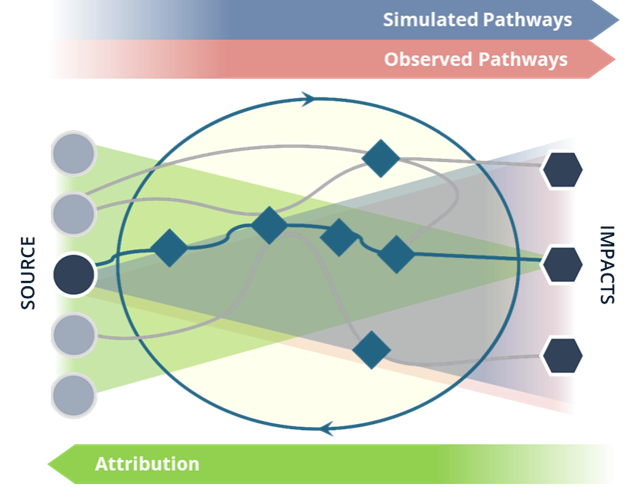
More than 30 people from Sandia and the University of Illinois Urbana-Champaign participated in a workshop on Feb. 11 focused on climate-modeling research. The workshop was the fourth in a yearlong series centered on climate security topics and designed to create interactions between Sandia researchers and university faculty and students.
“The idea is to get people together and get them engaged, so they know what each other is doing and what expertise each is bringing to the table,” explained Brenda Wilson, microbiology professor at the university and Sandia faculty fellow for the Office of the Vice Chancellor for Research and Innovation. From there, she added, participants can identify additional perspectives and gaps that can be filled through cooperation, which often leads to new projects and funding proposals.
Mallory Stites, a University of Illinois Urbana-Champaign campus partnership manager for Sandia, along with Matt Windsor, said that for the Labs, University of Illinois Urbana-Champaign and other universities have capabilities and resources that make partnering with academia both complementary and valuable. “The more we can figure out what universities are doing to stay on the cutting edge of climate science and then bring it into our work makes it a force multiplier for achieving our missions,” Mallory said.
University of Illinois Urbana-Champaign is part of Sandia’s University Partnerships Network, which supports university partnerships to increase the Labs’ impact and solve big problems. According to Amy Halloran, Sandia’s University of Illinois Urbana-Champaign campus executive and director of the Nuclear Fuel Cycle and Grid Modernization Center, this relationship has been so successful because the university’s strengths in engineering and applied work translate well to what we do at Sandia. Currently, more than 300 staff possess over 400 degrees from University of Illinois Urbana-Champaign.
With that successful history in mind, the workshop organizers wanted to use this series as an opportunity to expand outreach to other academic programs.
“Faculty in other areas — atmospheric sciences, biology, genomics, geology, mathematics, statistics and more — were doing exciting things in alignment with Sandia’s work,” said Wilson. “We also saw a lot of interest in climate and environmental policy topics, so it made sense to engage those people, too.”
In addition to climate change being a broad topic that intersects with multiple disciplines, this issue is gaining traction as a strategic priority for Sandia because of the national and global security threats it poses. Further, the climate crisis can’t be addressed by Sandia alone. “Partnerships with universities help us leverage what Sandia can do,” Wilson said.
Previous workshops in this series covered the water-energy-climate nexus and geological carbon storage. This particular workshop was the second to tackle the topic of climate modeling.
Presentations by University of Illinois Urbana-Champaign researchers revealed a broad range of climate modeling activities, from advancing methods to simulate complex interactions between the atmosphere and oceans, to combining observations, numerical models and statistical tools to better predict regional impacts of extreme weather. This research not only advances the science of climate modeling but also builds awareness of potential climate change risks, such as how increasing temperatures could impact agricultural yields.
Sandia’s portion of the workshop highlighted the CLDERA, or Climate impact: Determining etiology through pathways, Grand Challenge project, with presentations from Diana Bull, principal investigator, and Laura Swiler, attribution lead, as well as a presentation from Kenny Chowdhary on autotuning funded by DOE’s Office of Science. CLDERA seeks to develop new methods to attribute climate impacts to source events using a novel pathways approach. Attribution of the source of an impact is needed to guide liability, policy, treaty and national security decisions, especially as climate intervention strategies are being proposed as options to reduce the negative impacts of climate change.
“Establishing connective relationships in climate is hard because of confounding characteristics like high internal variability in earth systems, limited ensemble members from earth systems models and historically limited observational data,” said Diana. “We want to move beyond a correlative approach to establish connective relationships in a way that’s not just about a single source and a single impact. Our novel approach is focused on tracing how a source drives the climate system to respond with varied impacts.”
This collaborative project draws on Sandia’s capabilities in modeling and simulation, detection and attribution, risk analysis, high-reliability engineering, as well as the expertise of four academic partners, including University of Illinois Urbana-Champaign.
As discussion was winding down, the question of how to capitalize on all the overlapping interests discovered through the workshop revealed another goal of this partnership: to create career pathways for students from University of Illinois Urbana-Champaign to Sandia. One of the easiest ways to start collaborating is to get students involved in joint projects, such as through internships and postdoctoral appointments at Sandia.
In general, Mallory said that the workshop series has been a great way to get early-career researchers excited about Sandia’s climate security-related research and to show students outside of engineering disciplines that there is room for their skills at Sandia. “We are creating a community of common researchers.”